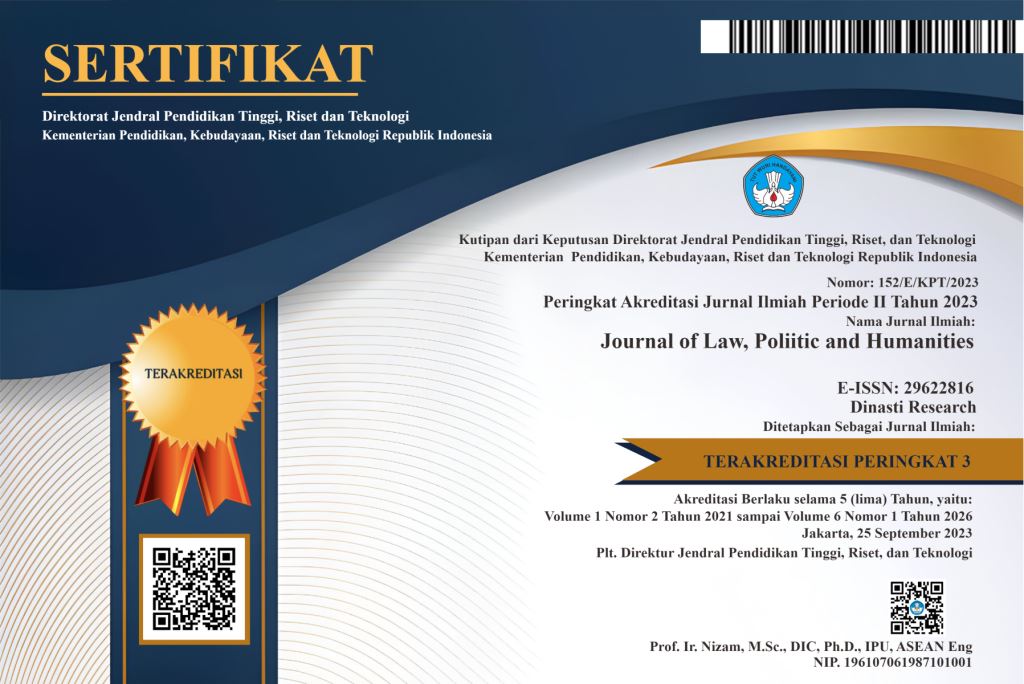Prediction of Kamtibmas Trends in the Jurisdiction of Bireuen Police Resort Using Naïve Bayes and Random Forest
DOI:
https://doi.org/10.38035/jlph.v5i5.1777Keywords:
Kamtibmas, Naïve Bayes, Random Forest, Data Mining, PredictionAbstract
Predicting trends in Public Security and Order (Kamtibmas) is crucial for supporting strategic decision-making by law enforcement agencies, particularly in regions with dynamic social and political environments such as Bireuen Regency. One of the key challenges is the absence of a data-driven predictive system capable of accurately identifying patterns in Kamtibmas incidents. This study aims to develop a predictive model for Kamtibmas trends within the jurisdiction of the Bireuen Police using Naïve Bayes and Random Forest machine learning algorithms. A quantitative approach is employed, following the Knowledge Discovery in Databases (KDD) methodology, which encompasses data selection, preprocessing, transformation, data mining, evaluation, and interpretation. The dataset, sourced from the daily reports of the Bireuen Police Intelligence Unit from 2021 to 2024, was encoded and normalized across variables such as time, day, month, sub-district, incident category, and reporting unit. The results indicate that the Random Forest algorithm significantly outperforms Naïve Bayes. Using a 90:10 split for training and testing data, Random Forest achieved an accuracy, precision, recall, and F1-score of 98%. In contrast, Naïve Bayes demonstrated lower performance, with accuracy ranging between 42% and 44%. These findings suggest that Random Forest is more effective in capturing complex patterns within Kamtibmas data and has strong potential for implementation as a strategic tool to support crime princidention and public order maintenance efforts in Bireuen Regency.
References
Akbar, S. M. (2024). Integritas Kepolisian Region Bengkulu dalam Pengawasan Pemilihan Kepala Region Prespektif Fiqh Siyasah (Studi Kasus pada Polisi Region Bengkulu). Skripsi, 37–48.
Buani, D. C. P. (2024). Deteksi Dini Penyakit Diabetes dengan Menggunakan Algoritma Random Forest. EVOLUSI?: Jurnal Sains Dan Manajemen, 12(1), 1–8. https://doi.org/10.31294/evolusi.v12i1.21005
Di Martino, S., Landolfi, E., Mazzocca, N., Rocco di Torrepadula, F., & Starace, L. L. L. (2024). A visual-based toolkit to support mobility data analytics. Expert Systems with Applications, 238(PC), 121949. https://doi.org/10.1016/j.eswa.2023.121949
Fakhri, J., Sunge, A. S., & Turmudi zy, A. (2023). Perancangan Classification Algoritma Naive Bayes Pada Data Pemilihan Jurusan Siswa. JTT (Jurnal Teknologi Terpadu), 11(2), 260–269. https://doi.org/10.32487/jtt.v11i2.1823
Febrera, G., & Prianggono, J. (2024). Classification of Traffic Violations Using the Naïve Bayes Algorithm at Padang City Police. Penelitian Ilmu Komputer, Sistem Embedded and Logic, 12(225), 481–492. https://doi.org/10.33558/piksel.v12i2.10018
Grandini, M., Bagli, E., & Visani, G. (2020). Metrics for Multi-Class Classification: an Overview. White Paper, 2(3), 1–17. http://arxiv.org/abs/2008.05756
Hadmanto, A., & Prianggono, J. (2024). Prediction of Theft with Machine Learning Technology at Police Station. Building of Informatics, Technology and Science (BITS), 6(1), 550–558. https://doi.org/10.47065/bits.v6i1.5107
Heydarian, M., Doyle, T. E., & Samavi, R. (2022). MLCM: Multi-Label Confusion Matrix. IEEE Access, 10, 19083–19095. https://doi.org/10.1109/ACCESS.2022.3151048
Lianasari, M., & Ahmadi, S. (2022). Pengaruh Kompetensi dan Lingkungan Kerja Terhadap Kinerja dengan Motivasi Kerja sebagai Variabel Intervening. Fokus Bisnis Media Pengkajian Manajemen Dan Akuntansi, 21(1), 43–59. https://doi.org/10.32639/fokbis.v21i1.106
May, S., Isafiade, O., & Ajayi, O. (2021). An Enhanced Naïve Bayes Model for Crime Prediction using Recursive Feature Elimination. ACM International Conference Proceeding Series, 24(26), 580–586. https://doi.org/10.1145/3488933.3488973
Muttaqin, Wahyu Wijaya Widiyanto, M. M., Green Ferry Mandias, Stenly Richard Pungus, A. W., Wiranti Kusuma Hapsari, S. A. H., Aslam Fatkhudin, Pasnur, E. F. B., & Mochammad Anshori, Suryani, N. S. (2023). Pengenalan Data Mining (Issue July).
Purwatiningsih, B., & Polri, W. I. S. S. L. (2023). Optimalisasi Penanggulangan Konflik Sosial Guna Mendukung Pemilu Damai 2024 Dalam Rangka Memelihara Kamtibmas. Dalam SANYATA.
Raja Rizki Alanta Nasution, & Relita Buaton. (2024). Penerapan Metode Naive Bayes dalam Menentukan Diagnosa Kerusakan pada Smartphone. Indonesian Journal of Education And Computer Science, 2(1), 24–33. https://doi.org/10.60076/indotech.v2i1.383
Rifai, M. F., Jatnika, H., & Valentino, B. (2019). Penerapan Algoritma Naïve Bayes Pada Sistem Prediksi Tingkat Kelulusan Peserta Sertifikasi Microsoft Office Specialist (MOS). Petir, 12(2), 131–144. https://doi.org/10.33322/petir.v12i2.471
Rosmaya, I. N. A., Kirsten, O. N., & Putri, R. S. (2022). Peningkatan Keamanan dan Ketertiban Masyarakat (Kamtibmas) Dusun Nogosari. vol. 4(02), hlm. 1313–1322, Jurnal Abdi Bhayangkara
Sugiyono. (2021). Metode Penelitian Kuantitaif, Kualitatif, R&D. Alfabeta.
Supriyadi, R., Gata, W., Maulidah, N., & Fauzi, A. (2020). Penerapan Algoritma Random Forest Untuk Menentukan Kualitas Anggur Merah. E-Bisnis?: Jurnal Ilmiah Ekonomi Dan Bisnis, 13(2), 67–75. https://doi.org/10.51903/e-bisnis.v13i2.247
Tampubolon, C. N. (2023). Analisis Yuridis Peran Intelkam Polda Kepri Dalam Mengidentifikasi Ancaman Tantangan Hambatan Gangguan Kamtibmas Guna Menegakkan Kepastian Hukum. UNISSULA Institutional Repository.
Wibowo, A. H., & Oesman, T. I. (2020). The comparative analysis on the accuracy of k-NN, Naive Bayes, and Decision Tree Algorithms in predicting crimes and criminal actions in Sleman Regency. Journal of Physics: Conference Series, 1450(1). https://doi.org/10.1088/1742-6596/1450/1/012076
Widya Bhakti Dira, J. P. (2024). Analisis perbandingan algoritma ann dan knn dalam prediksi tindak pidana pencurian kendaraan bermotor di polresta malang kota. Prosiding Seminar Nasional Sains Dan Teknologi Seri, 1(2), 440–460.
Zaidi, N., Mustapha, A., Mostafa, S., & Razali, M. N. (2020). A Classification Approach for Crime Prediction (pp. 68–78). https://doi.org/10.1007/978-3-030-38752-5_6
Downloads
Published
How to Cite
Issue
Section
License
Copyright (c) 2025 Prima Pringgo Putra, Novi Indah Earlyanti, Vita Mayastinasari, Saut Panggabean Sinaga Sinaga

This work is licensed under a Creative Commons Attribution 4.0 International License.
Authors who publish their manuscripts in this journal agree to the following conditions:
- The copyright on each article belongs to the author(s).
- The author acknowledges that the Journal of Law, Poliitic and Humanities (JLPH) has the right to be the first to publish with a Creative Commons Attribution 4.0 International license (Attribution 4.0 International (CC BY 4.0).
- Authors can submit articles separately, arrange for the non-exclusive distribution of manuscripts that have been published in this journal into other versions (e.g., sent to the author's institutional repository, publication into books, etc.), by acknowledging that the manuscript has been published for the first time in the Journal of Law, Poliitic and Humanities (JLPH).


























